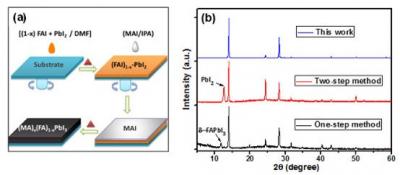A research team from Japan's National Institute for Materials Science (NIMS) has developed a new method of fabricating high-quality perovskite materials, capable of utilizing longer-wavelength sunlight of 800 nm or longer. The method may mark a new approach to enhance the efficiency of perovskite solar cells.

Perovskite solar cells currently possess optical absorption spectra that lean toward shorter wavelengths. To improve the energy conversion efficiency of these cells, it is crucial to develop perovskite materials with optical absorption spectra expanded to include longer wavelengths. This is why several research institutes are developing perovskite materials that include two types of cations, MA and FA, capable of absorbing light in the longer wavelength region. However, these cations are not without issues - mainly that their mixing ratio and crystallization temperature are difficult to control. Moreover, due to their tendency to form a mixed crystal phase, there had been no effective method established to fabricate high-purity, single-crystalline perovskite materials.
Now, the researchers designed a method that enables the creation of perovskite materials with a 40 nm wider optical absorption spectrum, a high short-circuit current and high open-circuit voltage. The method was used to fabricate a new type of mixed cation-based perovskite material. A pure, single-crystalline precursor material, (FAI)1-xPbI2, was fabricated under altering temperatures. A reaction was performed between the precursor and MAI (methylammonium iodide). The resulting perovskite material, (MA)xFA1-xPbI3, was a single crystalline phase and had a long fluorescence lifetime. The observations indicated that electrons in the material rarely recombine and they have long lifetimes. The optical absorption spectrum of the solar cells employing this material covered up to 840 nm, which was 40 nm wider than the spectrum of conventional perovskite material (MA3PbI3). As a result, the solar cells that were developed obtained 1.4 mA/cm2 higher short-circuit current than the MAPbI3 solar cells that were manufactured under the same conditions.
The researchers intend to continue their studies in order to develop high-quality perovskite solar cells capable of utilizing a broader spectrum of sunlight by adjusting the ratio of the two cations.

